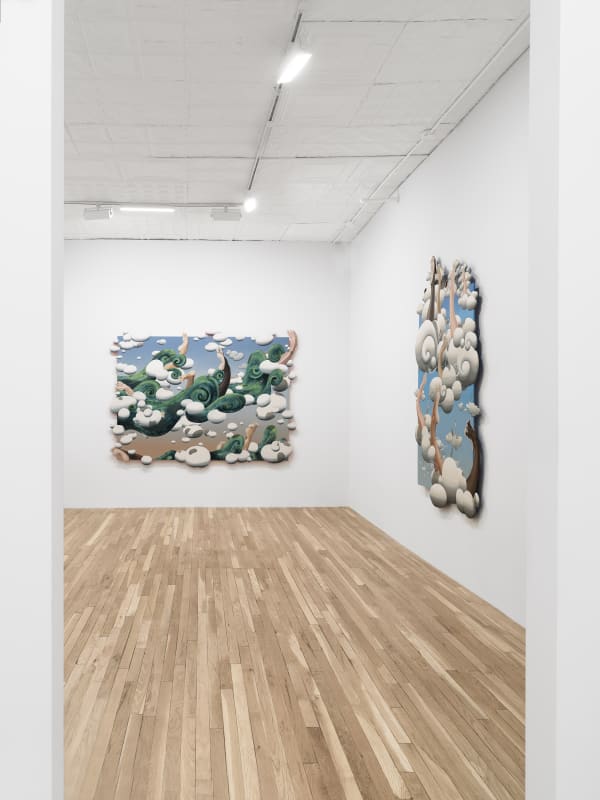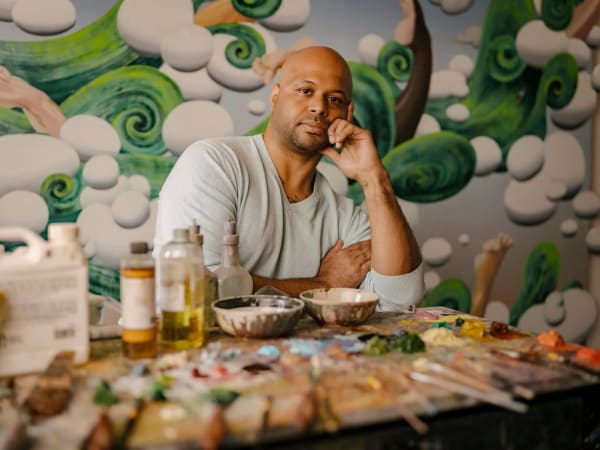Miguel Ángel Payano Jr.: Out From
Past exhibition
Overview
Charles Moffett is pleased to present Out From, a solo exhibition of new works by Bronx-based artist Miguel Ángel Payano Jr.
Following a series of collaborations in 2021, including a solo exhibition and a presentation at NADA Miami, this marks the artist's first solo exhibition with the gallery since officially joining the program last spring.
Works
Installation Views
Press
Press release
Out From, a solo exhibition of new works by Bronx-based artist Miguel Ángel Payano Jr. Following a series of collaborations in 2021, including a solo exhibition and a presentation at NADA Miami, this marks the artist's first solo exhibition with the gallery since officially joining the program last spring.
Born in an Afro-Caribbean family in New York and studying in New England before moving to China in his twenties, Payano has always had to navigate between and among several languages and cultures. Learning to communicate across these contexts, Payano became increasingly attuned to the importance of language in our understanding of and relation to one another. Now living and working between New York and Beijing, the mouth-carved from the form of a peach-has become an anchoring image in Payano's practice. While earlier in his career Payano worked mostly in paint, in recent years his practice has radically expanded to embrace sculptural and quasi-sculptural forms - with his peach-mouths joined by other images, textures, and found, transformed, and assembled objects that form uncanny, humor-filled portraits that fuse painting and sculpture.
The choice of a peach is a highly deliberate one. In Chinese culture, the fruit is a potent symbol of springtime, fertility, and most significantly long life. Their presence evokes a safeguard for the health and longevity of the mystical subjects of Payano's portraits - figures adorned in all manners of dress, hair-stylings, and headwear, set within a variety of real and imagined landscapes. In the latest series of six sculptural paintings on view here, the carved peach mouths are newly held by casts of human hands and forearms - live-casts that Payano has been making of his own body increasingly over the last few years. This timing coincided with the artist's learning of a life-altering medical diagnosis that has had an indelible impact upon his work. Building on the peach's evocation of long life, the plaster-cast forearms and hands emerging from the painted and collaged wood panels freeze the artist's hands in time, eternalizing his body in a form of his own desire, resistant to the effects of aging or illness.
Elsewhere in the exhibition, human limbs, calves and feet in particular, recur in a new series of large-scale oil and acrylic paintings on panel. Rendered in twisted and disjointed angles, the legs and feet appear swept up by currents of swirling waves and clouds - outsized natural forces that overwhelm the human body's power and will. This presence of waves and clouds, symbolic forms frequently used across Asian art, coupled with the artist's use of a flattened perspective in these paintings, all underscore the distinctive influence Payano has drawn from his years living and practicing in China. As opposed to linear, single-point perspective traditionally used across Western art, flattened perspective explodes that singularity, allowing for multiple focal points and the representation of evolving time and space within a unified composition. The multiplicity of potential focal points is a vital element within Payano's work - as an artist that has lived and worked across radically different cultures, languages, and countries, the idea that the same phenomenon can appear dramatically different depending on the perspective of the viewer has long captivated his creative attention.
Payano, however, further complicates his use of flattened perspective by using shadows to add volume to his painted forms, collaging materials atop the panel, and applying a neon backing to give many of his pieces a three-dimensional auratic glow. The exhibition's title, Out From, is a play on that multi-dimensionality and draws upon the phrase's both literal and metaphorical meanings. While the sculptural forms and collaged elements that comprise the portraits are the most three-dimensional pieces in the show, looking throughout the gallery, one sees forms breaking out from the canvas and the picture plane in all manner of ways. The boundaries of his rectangular paintings are continuously disrupted, whether by flexed feet or egg-like cloud formations; whereas Payano breaks the planes of his large-scale round panel paintings by carefully applying collaged leaves emerging from the surface of painted ones, garnering a trompe-l'œil-like effect.
In a refusal to follow the restrictions and rules of either Eastern or Western methods of representation, the artist has created an artistic universe and representational language all his own. Forged through his ever-winding cultural and geographic journeys, his unbridled disciplinary experimentations, his life-fueling commitment to art in the face of acute challenge, this language is singular to Payano; yet through his works, that language communicates truths of our human condition - connection, joy, mortality - in notes universally understood.
Miguel Ángel Payano Jr. (b. 1980, New York, New York; lives and works between the Bronx, New York and Beijing, China. MFA Hunter College 2021, New York; MFA Central Academy of Fine Arts (CAFA), Beijing 2008; BA Williams College 2003.) Payano has shown his work widely around the world, including recent solo exhibitions at Galleria Poggiali in Milan (2022), Make Room in Los Angeles (2021), and Charles Moffett in New York (2021); as well as recent gallery group exhibitions at Simon Lee in London (2022), Ben Brown Fine Arts in Hong Kong (2022), and Droste Gallery in Paris (2021). His work is currently on view at the Orlando Museum of Art and has been featured in past institutional exhibitions at the Museum of Contemporary Art Santa Barbara and the Eastville Museum.
Born in an Afro-Caribbean family in New York and studying in New England before moving to China in his twenties, Payano has always had to navigate between and among several languages and cultures. Learning to communicate across these contexts, Payano became increasingly attuned to the importance of language in our understanding of and relation to one another. Now living and working between New York and Beijing, the mouth-carved from the form of a peach-has become an anchoring image in Payano's practice. While earlier in his career Payano worked mostly in paint, in recent years his practice has radically expanded to embrace sculptural and quasi-sculptural forms - with his peach-mouths joined by other images, textures, and found, transformed, and assembled objects that form uncanny, humor-filled portraits that fuse painting and sculpture.
The choice of a peach is a highly deliberate one. In Chinese culture, the fruit is a potent symbol of springtime, fertility, and most significantly long life. Their presence evokes a safeguard for the health and longevity of the mystical subjects of Payano's portraits - figures adorned in all manners of dress, hair-stylings, and headwear, set within a variety of real and imagined landscapes. In the latest series of six sculptural paintings on view here, the carved peach mouths are newly held by casts of human hands and forearms - live-casts that Payano has been making of his own body increasingly over the last few years. This timing coincided with the artist's learning of a life-altering medical diagnosis that has had an indelible impact upon his work. Building on the peach's evocation of long life, the plaster-cast forearms and hands emerging from the painted and collaged wood panels freeze the artist's hands in time, eternalizing his body in a form of his own desire, resistant to the effects of aging or illness.
Elsewhere in the exhibition, human limbs, calves and feet in particular, recur in a new series of large-scale oil and acrylic paintings on panel. Rendered in twisted and disjointed angles, the legs and feet appear swept up by currents of swirling waves and clouds - outsized natural forces that overwhelm the human body's power and will. This presence of waves and clouds, symbolic forms frequently used across Asian art, coupled with the artist's use of a flattened perspective in these paintings, all underscore the distinctive influence Payano has drawn from his years living and practicing in China. As opposed to linear, single-point perspective traditionally used across Western art, flattened perspective explodes that singularity, allowing for multiple focal points and the representation of evolving time and space within a unified composition. The multiplicity of potential focal points is a vital element within Payano's work - as an artist that has lived and worked across radically different cultures, languages, and countries, the idea that the same phenomenon can appear dramatically different depending on the perspective of the viewer has long captivated his creative attention.
Payano, however, further complicates his use of flattened perspective by using shadows to add volume to his painted forms, collaging materials atop the panel, and applying a neon backing to give many of his pieces a three-dimensional auratic glow. The exhibition's title, Out From, is a play on that multi-dimensionality and draws upon the phrase's both literal and metaphorical meanings. While the sculptural forms and collaged elements that comprise the portraits are the most three-dimensional pieces in the show, looking throughout the gallery, one sees forms breaking out from the canvas and the picture plane in all manner of ways. The boundaries of his rectangular paintings are continuously disrupted, whether by flexed feet or egg-like cloud formations; whereas Payano breaks the planes of his large-scale round panel paintings by carefully applying collaged leaves emerging from the surface of painted ones, garnering a trompe-l'œil-like effect.
In a refusal to follow the restrictions and rules of either Eastern or Western methods of representation, the artist has created an artistic universe and representational language all his own. Forged through his ever-winding cultural and geographic journeys, his unbridled disciplinary experimentations, his life-fueling commitment to art in the face of acute challenge, this language is singular to Payano; yet through his works, that language communicates truths of our human condition - connection, joy, mortality - in notes universally understood.
Miguel Ángel Payano Jr. (b. 1980, New York, New York; lives and works between the Bronx, New York and Beijing, China. MFA Hunter College 2021, New York; MFA Central Academy of Fine Arts (CAFA), Beijing 2008; BA Williams College 2003.) Payano has shown his work widely around the world, including recent solo exhibitions at Galleria Poggiali in Milan (2022), Make Room in Los Angeles (2021), and Charles Moffett in New York (2021); as well as recent gallery group exhibitions at Simon Lee in London (2022), Ben Brown Fine Arts in Hong Kong (2022), and Droste Gallery in Paris (2021). His work is currently on view at the Orlando Museum of Art and has been featured in past institutional exhibitions at the Museum of Contemporary Art Santa Barbara and the Eastville Museum.































